Want a brighter, more colorful display that uses less power? Quantum dots may be the answer.
After 25 years of research and development, quantum dots – man-made semiconducting crystals so tiny they are invisible to the naked eye – are ready for their close-up.
Quantum dots (QDs) could be the next big thing in display technology, allowing screens to display brighter, more realistically vivid colors but without draining battery life, recent research suggests.
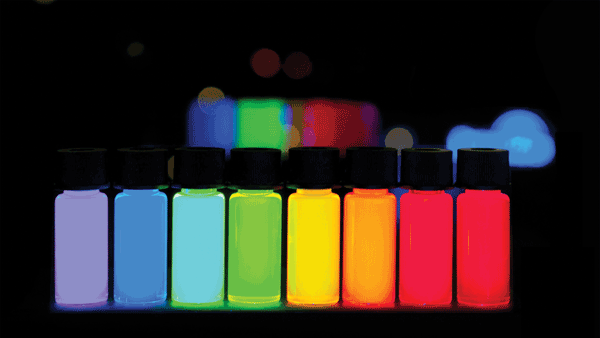
Quantum dots with vivid colors stretching from violet to deep red are currently manufactured on a large scale at PlasmaChem GmbH. Photo courtesy of Wikimedia Commons.
QDs could bring dramatic improvements to LCDs in terms of color range, accuracy and power consumption, said Dr. Jennifer Colegrove, an analyst and president of Touch Display Research Inc., in January. “This is one of the biggest breakthrough technologies for LCD in recent several years,” she added, noting that the QD-LCD is beginning to challenge the active-matrix organic LED (AMOLED). “We forecast quantum dot components will have a rapid penetration into LCDs from 2014 to 2023.”
The quantum dot display component market surpassed $70 million in 2013, according to a December survey of quantum dot suppliers conducted by Touch Display Research; QDs for displays and lighting components will reach $9.6 billion by 2023, the firm predicted.
The optical and electrical properties of the manufactured crystals can vary markedly according to their size and shape: The bigger the dot, the larger its bandgap and the longer the wavelength it emits. The smaller the dot, the smaller its bandgap – which means a shorter wavelength due to the quantum confinement of electrons and holes in these nanomaterials.
Quantum dots offer marked advantages over fixed-spectrum conventional phosphor technologies because QDs are tunable, so they can be induced to emit at a very narrow wavelength. Improvements to the technology in recent years are also making them more attractive. For example, Dr. Geoffrey Supran of MIT and colleagues have increased the external quantum efficiency of electrically driven colloidal QD-LEDs from less than 0.01 percent to around 18 percent, as reported in the Materials Research Society’s MRS Bulletin (doi: 10.1557/mrs.2013.181). (For more information on the work of Supran and his group on colloidal quantum dots, see their 2013 Nature Photonics paper on the emergence of colloidal QD light-emitting technologies [doi:10.1038/nphoton.2012.328].)
With their narrow linewidth, the dots produce highly saturated colors and can be made to emit a purer white light containing only the precise colors needed by the display: red, green and blue.
Factors enabling this advance include better efficiency and tunability of LEDs. In September 2013, MRS Bulletin highlighted advances in QD-LEDs, especially for display applications, including work by Dr. Dmitri Talapin of the University of Chicago and Dr. Jonathan Steckel of QD Vision (doi: 10.1557/mrs.2013.204).
The improvements stem from several new material combinations and quantum dot designs.
“Quantum dots are now on the verge of widespread adoption in display applications, after 25 years of scientific research and over a decade of commercialization efforts,” wrote Dr. Seth Coe-Sullivan, founder and chief technology officer of QD Vision, and co-authors in a November 2012 paper that also was included in a 2013 special issue of ECS Journal of Solid State Science and Technology (doi: 10.1149/2.012302jss).
Coe-Sullivan and colleagues largely attributed the result to improvements in QD performance and manufacturing as an outgrowth of research in universities, national labs, and public and private companies.
“Following decades of pioneering academic and industrial work, the 2010s seems beyond doubt to be the decade of widespread product introduction, potentially penetrating into diverse markets such as displays, imaging, solar cells and thermoelectrics,” the researchers wrote in their paper.
Color me impressed
One of the ways quantum dots can dramatically improve displays is in color reproduction. Most flat-screen TVs display only about one-third of the colors visible to the human eye, according to Nanosys Inc., which promotes its quantum dot technology as enabling LCDs to show upward of 50 percent more color than the average display. Milpitas, Calif.-based Nanosys was founded in 2001 and has partnered with leading display makers such as Samsung.
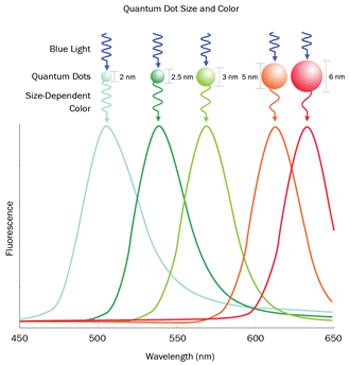
Quantum dot size relates to emission wavelength: QDs absorb higher-energy/shorter-wavelength light and downconvert it into lower-energy/longer-wavelength light. The smallest dot represented here, 2 nm in diameter, absorbs the light from a 450-nm blue source and emits at the 500-nm green wavelength; a larger 6-nm-diameter dot emits at the 630-nm red wavelength. Precise control of quantum dots during manufacturing enables the dots to emit light at any wavelength in the visible spectrum. Photo courtesy of Nanosys.
In a January 2013 Information Display paper, Nanosys’ R&D vice president, Dr. Jian Chen, and colleagues cited
the advances in colors made by displays recently via AMOLED technology, noting that, although OLEDs are far superior to LCDs in color reproduction, quantum dots are helping LCDs bridge that gap.
“Conventional LCDs face a ceiling in color performance, at best reaching the sRGB (standard RGB) color gamut, or about 70 percent of OLEDs’ capability,” the authors wrote, “because of the white LED light source used in most LCD backlights.” Efforts to improve these backlight sources have thus far proved to be too costly, too power hungry or too bulky to be practical, they added.
In addition, the authors pointed out, OLEDs lag behind manufacturing stalwart LCDs in widespread adoption largely because of cost and of manufacturers’ aversion to spending huge amounts of money to begin large-scale manufacturing of an unproven technology. To make adoption widespread, QD manufacture must be compatible with current LCD manufacturing techniques, they wrote. That’s where Nanosys says its quantum dot enhancement film (QDEF) comes in.
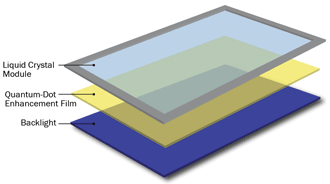
The quantum dot enhancement film (QDEF) is designed to replace the diffuser in an LCD backlight unit and is placed between the backlight and the liquid crystal module. The QDEF contains red- and green-emitting quantum dots and is illuminated by blue LEDs in the backlight. Photo courtesy of Nanosys.
QDEF is designed to replace an existing film in the backlight called the diffuser. The film combines trillions of red- and green-emitting quantum dots in a thin sheet that emits finely tuned white light when stimulated by blue light. Each sheet of QDEF is composed of three layers: two plastic barrier films sandwiching a layer of quantum dots suspended in a polymer matrix. A barrier film that protects the quantum dots from the outside environment is a critical component, Nanosys says, because QDs are just as vulnerable to oxygen and moisture as OLED materials are.
Of course, the film also needs to let as much light through as possible, and the film Nanosys uses was developed previously by 3M for solar, display and lighting applications.
“The result is a simple, ready-to-use product that manufacturers can directly integrate into existing processes,” the authors wrote in the Information Display paper. “By adding QDEF, the display maker can immediately begin producing LCD panels with color and efficiency performance beyond OLEDs, without making any changes to established processes.”
QDEF also can be custom-formulated for various display applications – some to widen the color gamut and some to increase energy/light efficiency, allowing display designers to tune the backlight spectrum to precise performance goals.
“Color is the next big differentiator in the increasingly competitive consumer display market. Display makers that can bring the user experience closer to reality with lifelike colors, without sacrificing efficiency or cost, will establish a dominant market position,” the authors wrote.
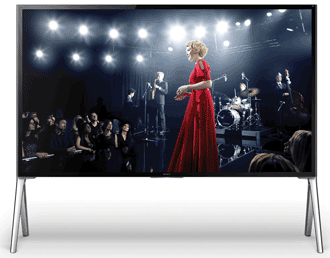
QD displays demonstrated at the Consumer Electronics Show in January included notebook computer- and home theater-sized screens such as the Sony UHDTV. Photo courtesy of Sony.
QDs hit the marketplace
Nanosys, 3M and Amazon brought quantum-dot tablet PCs to the market in 2013, according to the Touch Display Research report.
On Oct. 1, 2013, Nanosys announced that it had passed a major production milestone, shipping 2000 kg of quantum dot concentrate used to make QDEF, a sufficient amount to be incorporated into millions of devices.
That same week, Nanosys demonstrated a 55-in. 4K TV using QDEF technology at the IHS E&M Quantum Dot Seminar in Seoul, South Korea, which it said achieved about 40 percent higher color gamut than commercially available white-LED-based 4K televisions while reducing power consumption by more than 35 percent.
At the Consumer Electronics Show (CES) in January, Hisense displayed an 85-in. 4K wide-color-gamut quantum dot television that is expected to hit the US market in September 2014 – at prices competitive with LCD TVs. Several other manufacturers also demonstrated QD displays of various sizes at CES, from smartphone-sized devices such as the Kindle Fire HDX to notebook computer- and home theater-sized screens such as the Sony UHDTV.

Several manufacturers demonstrated QD displays of various sizes at the Consumer Electronics Show in January, including smartphone-sized devices such as the Kindle Fire HDX. Photo courtesy of Kindle.
“2014 looks to be the year that quantum dots gain serious traction in the display market after a strong debut in 2013,” wrote Jeff Yurek, head of corporate communications for Nanosys, in a January blog post on the company’s website.
Nanosys-created quantum dot display technology was featured in March at 3M’s booth at South by Southwest, a music, film and emerging technology conference and festival in Austin, Texas.
“Quantum dots are going to revolutionize and reenergize LCDs for the next 5+ years,” wrote Dr. Raymond M. Soneira, president of DisplayMate Technologies Corp., on the Amherst, N.H.-based company’s website earlier this year.
One way to commercialize something quickly is to attach it to the Apple brand. In February, Apple Insider news website revealed that, back in October 2012, Apple filed three patent applications with the US Patent and Trademark Office related to quantum-dot-enhanced displays. And rumor says Apple’s iPhone 6 will feature quantum dot technology in its screen when it debuts later this year.
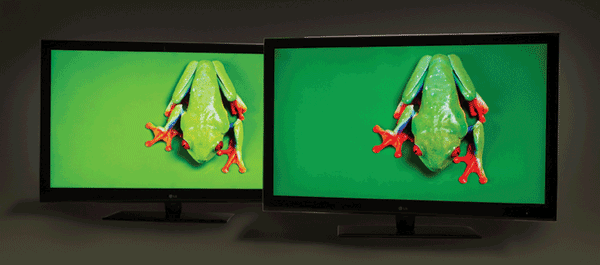
Comparison shot showing two 47-in. TVs with Quantum Dot Enhancement Film on the right and a YAG-based display at left. While the page can’t display the true difference in color, it is possible to see that the frog on the left is simply not as green (it looks somewhat yellowish in comparison). Photo courtesy of Jeff Yurek.
“Our research proves that wider color gamuts are key to visual appeal, which is why we will continue to see new, full-gamut LCD TVs with quantum dot optics announced in 2014 and beyond,” said QD Vision CEO Jason Carlson in February.
QD Vision’s Coe-Sullivan was blunt about the future of OLEDs in an early February 2014 presentation – “Are Quantum Dots Closing the Window of Opportunity for OLED-TV?” – at a Society for Information Display Los Angeles chapter conference. OLED-TV will become irrelevant in five years, Coe-Sullivan predicted in his talk.
In early March, QD Vision announced the commercial availability of the industry’s first green quantum dots at 30-nm full width half maximum, joining its 30-nm red QDs. Later that month, Coe-Sullivan chaired the first-of-its-kind Quantum Dots Forum in San Diego. The conference drew researchers, business executives and technologists with the opportunity to discuss trends, problems and solutions specific to the quantum dot industry.
Future challenges, applications
QD research is trying to move the crystals away from highly toxic materials such as cadmium and toward a more heavy-metal-free composition, such as silicon-based dots. Such quantum dots would also be less expensive.
“There currently exists huge demand potential for high-quality and low-priced quantum dots in mass-market applications in a range of consumer products. Commercialization of quantum dots in the coming years is expected to receive a major boost, supported by technology developments that help facilitate mass production. Growth in the solar energy industry and the ensuing interest in quantum dot printed solar cells are also expected to spur demand in the market,” wrote Global Industry Analysts (GIA) in a market report released in January.
GIA projects that the market for quantum dots will witness strong growth, led by developments in nanosemiconductors and expanding applications in display device photonics, in vivo selective tissue marking, in vitro cellular analysis, security inks, and diagnostic and imaging devices.
A Very Brief History of QDs
Quantum dots were created in the 1980s at Bell Labs (doi: 10.1063/1.445834). The process of growing them in solution – colloidal quantum dots – was pioneered by Bell Labs’ Dr. Louis E. Brus, who is now a professor of chemical engineering at Columbia University and who continues to explore the optical and electronic properties of nanocrystals. With his postdocs at Bell Labs in the mid-1980s, Dr. Paul Alivisatos and Dr. Moungi Bawendi, Brus made ever-smaller quantum dots for research.
Now an MIT professor, Bawendi, too, is a pioneer of quantum dot research and has developed QD applications in biological and biomedical imaging and sensing as well as in LEDs, photodetection and solar energy conversion. Bawendi has assisted four startup companies, including QD Vision, in commercializing quantum dot technology; a fifth company, spun out of his lab, is applying quantum dot research to a medical device.
The coining of the term “quantum dot” is attributed to Yale University physicist Dr. Mark Reed (see doi: 10.1103/PhysRevLett.60.535 and “Quantum-Dot Displays: Giving LCDs a Competitive Edge Through Color,” the January 2013 Information Display paper by Jian Chen, Veeral Hardev and Jeff Yurek of Nanosys). The term refers to the devices’ quantum-confinement properties.